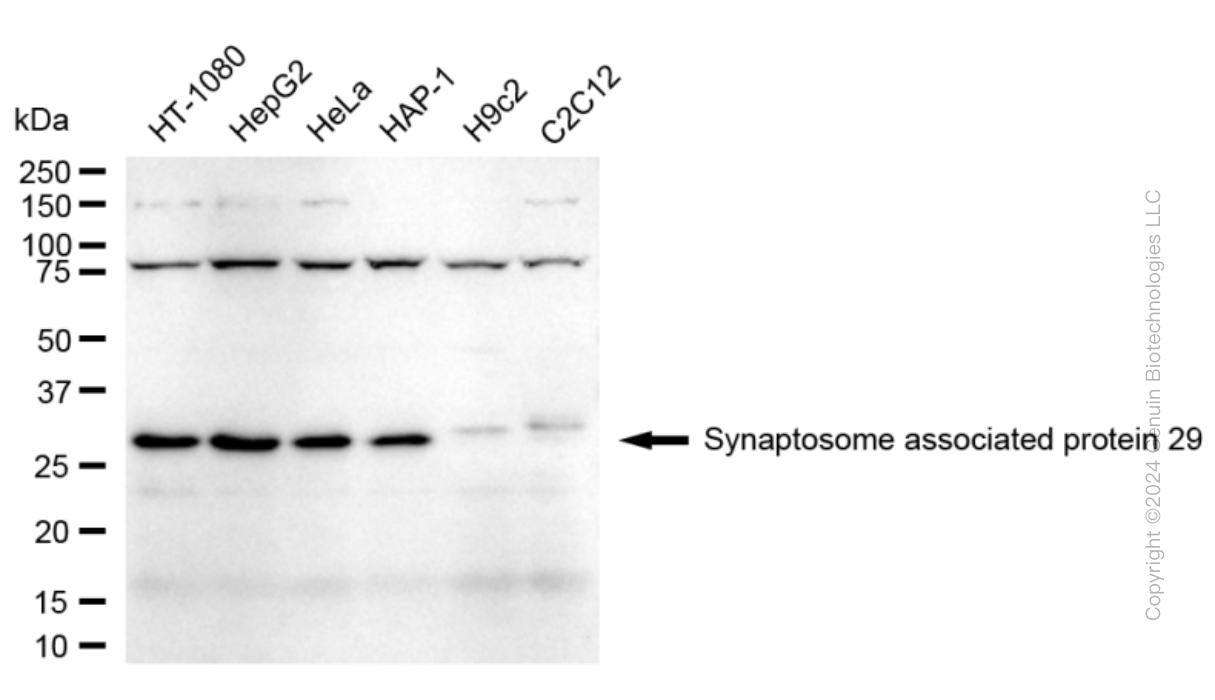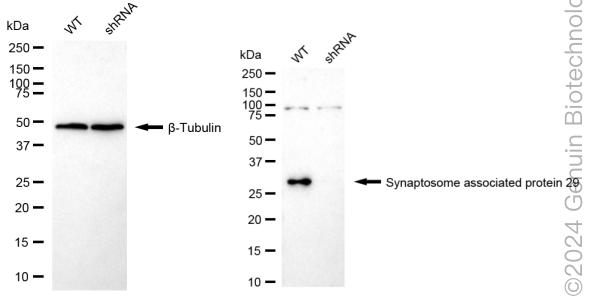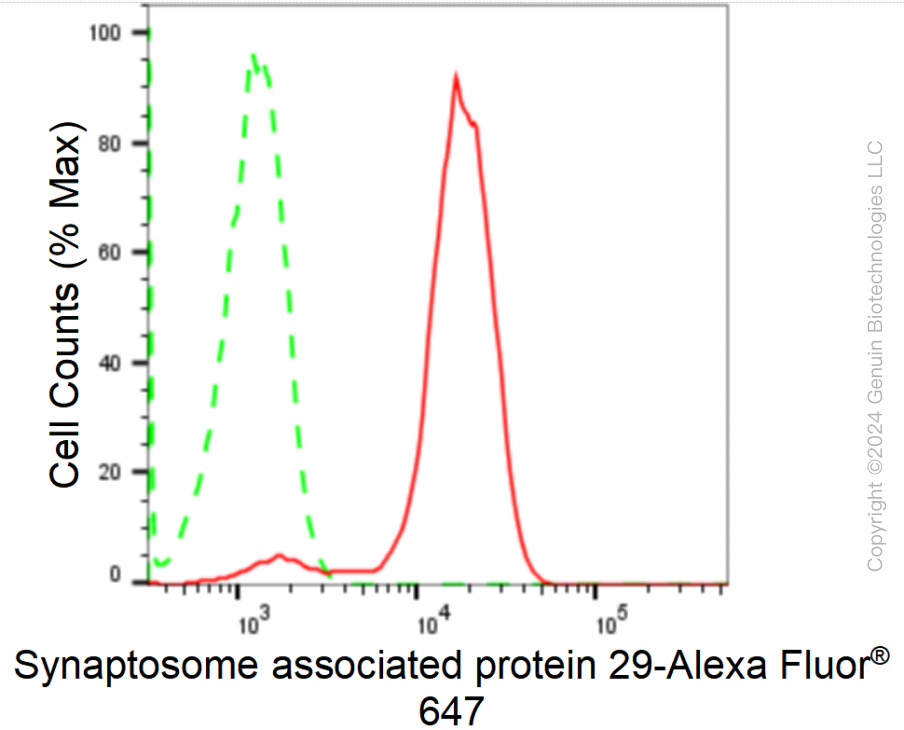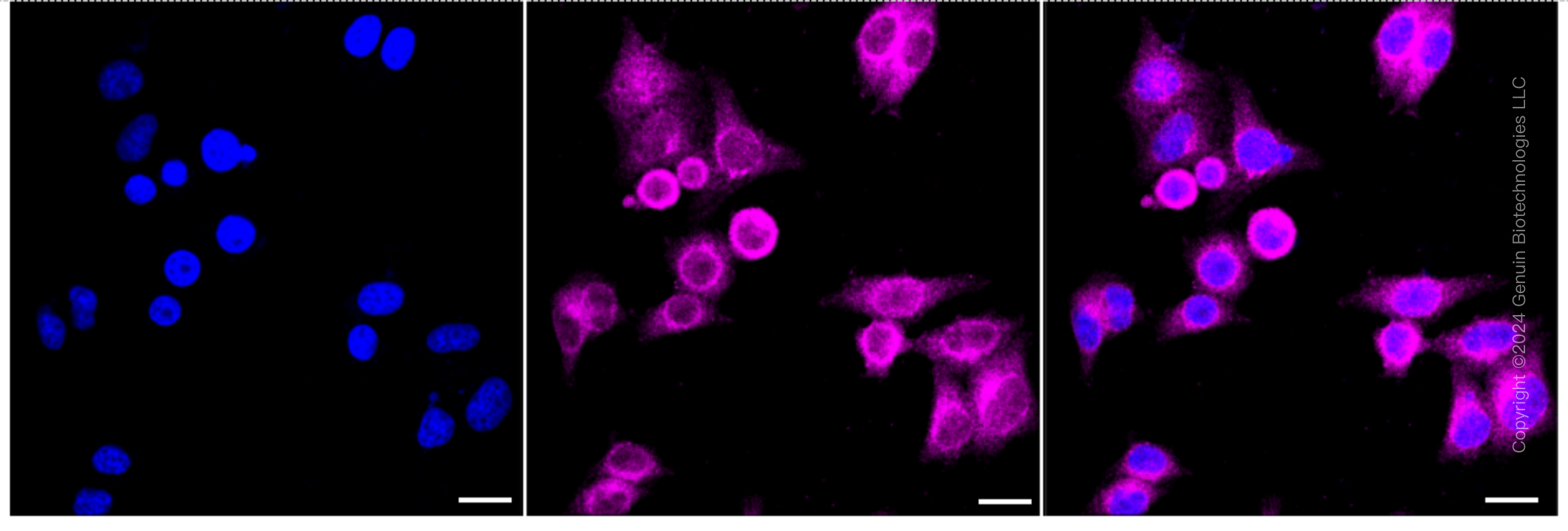KD-Validated Anti-Synaptosome Associated Protein 29 Rabbit Monoclonal Antibody
Rabbit monoclonal antibody
- SPECIFICATION
- CITATIONS
- PROTOCOLS
- BACKGROUND

Application
| WB, FC, ICC |
|---|---|
| Primary Accession | O95721 |
| Reactivity | Rat, Human, Mouse |
| Clonality | Monoclonal |
| Isotype | Rabbit IgG |
| Clone Names | 24GB1855 |
| Calculated MW | Predicted, 29 kDa , observed , 27 kDa |
| Gene Name | SNAP29 |
| Aliases | SNAP29; Synaptosome Associated Protein 29; SNAP-29; Soluble 29 KDa NSF Attachment Protein; CEDNIK; Cerebral Dysgenesis, Neuropathy, Ichthyosis And Keratoderma Syndrome; Vesicle-Membrane Fusion Protein SNAP-29; Synaptosomal-Associated Protein, 29kDa; Synaptosomal-Associated Protein 29; Synaptosomal-Associated Protein, 29kD; Synaptosome Associated Protein 29kDa |
| Immunogen | A synthesized peptide derived from human SNAP29 |
| Gene ID | 9342 |
|---|---|
| Other Names | Synaptosomal-associated protein 29 {ECO:0000312|HGNC:HGNC:11133}, SNAP-29 {ECO:0000312|HGNC:HGNC:11133}, Soluble 29 kDa NSF attachment protein {ECO:0000312|HGNC:HGNC:11133}, Vesicle-membrane fusion protein SNAP-29, SNAP29 (HGNC:11133) |
| Name | SNAP29 (HGNC:11133) |
|---|---|
| Function | SNAREs, soluble N-ethylmaleimide-sensitive factor-attachment protein receptors, are essential proteins for fusion of cellular membranes. SNAREs localized on opposing membranes assemble to form a trans-SNARE complex, an extended, parallel four alpha-helical bundle that drives membrane fusion. SNAP29 is a SNARE involved in autophagy through the direct control of autophagosome membrane fusion with the lysososome membrane. Also plays a role in ciliogenesis by regulating membrane fusions. |
| Cellular Location | Cytoplasm. Golgi apparatus membrane {ECO:0000250|UniProtKB:Q9Z2P6}; Peripheral membrane protein. Cytoplasmic vesicle, autophagosome membrane; Peripheral membrane protein. Cell projection, cilium membrane; Peripheral membrane protein. Note=Appears to be mostly membrane-bound, probably via interaction with syntaxins, but a significant portion is cytoplasmic Localizes to the ciliary pocket from where the cilium protrudes |
| Tissue Location | Found in brain, heart, kidney, liver, lung, placenta, skeletal muscle, spleen and pancreas |

Thousands of laboratories across the world have published research that depended on the performance of antibodies from Abcepta to advance their research. Check out links to articles that cite our products in major peer-reviewed journals, organized by research category.
info@abcepta.com, and receive a free "I Love Antibodies" mug.
Provided below are standard protocols that you may find useful for product applications.
If you have used an Abcepta product and would like to share how it has performed, please click on the "Submit Review" button and provide the requested information. Our staff will examine and post your review and contact you if needed.
If you have any additional inquiries please email technical services at tech@abcepta.com.














 Foundational characteristics of cancer include proliferation, angiogenesis, migration, evasion of apoptosis, and cellular immortality. Find key markers for these cellular processes and antibodies to detect them.
Foundational characteristics of cancer include proliferation, angiogenesis, migration, evasion of apoptosis, and cellular immortality. Find key markers for these cellular processes and antibodies to detect them. The SUMOplot™ Analysis Program predicts and scores sumoylation sites in your protein. SUMOylation is a post-translational modification involved in various cellular processes, such as nuclear-cytosolic transport, transcriptional regulation, apoptosis, protein stability, response to stress, and progression through the cell cycle.
The SUMOplot™ Analysis Program predicts and scores sumoylation sites in your protein. SUMOylation is a post-translational modification involved in various cellular processes, such as nuclear-cytosolic transport, transcriptional regulation, apoptosis, protein stability, response to stress, and progression through the cell cycle. The Autophagy Receptor Motif Plotter predicts and scores autophagy receptor binding sites in your protein. Identifying proteins connected to this pathway is critical to understanding the role of autophagy in physiological as well as pathological processes such as development, differentiation, neurodegenerative diseases, stress, infection, and cancer.
The Autophagy Receptor Motif Plotter predicts and scores autophagy receptor binding sites in your protein. Identifying proteins connected to this pathway is critical to understanding the role of autophagy in physiological as well as pathological processes such as development, differentiation, neurodegenerative diseases, stress, infection, and cancer.





